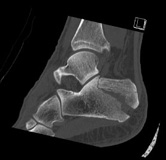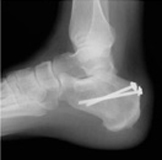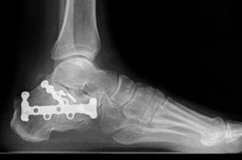Calcaneus Fracture - Heel Bone (Part Two)
Tests
Other tests that may help your doctor confirm the diagnosis include:
Radiography: This test is the most common and widely available diagnostic technique. Radiography creates images of dense structures, like bones, making them especially useful in showing fractures.
Computed Tomography (CT Scan): After examining your foot with radiography, your doctor may recommend a CT scan of your foot. This tool combines X-ray images with computer technology to produce a more detailed, cross-sectional image of your body. It provides your doctor with valuable information regarding the severity of the fracture. The CT scan helps your doctor plan your treatment. The doctor will show you images to help you understand the nature and weight, the severity of your injury.
Treatment
In planning your treatment, the doctor will consider several things, including:
- The cause of your injury
- Your overall health
- The severity of your injury
- The extent of soft tissue damage
Since most fractures of the calcaneus cause expansion of the bone, the goal of treatment is to restore the normal anatomy of the heel. In general, patients who have preservation of heel anatomy generally have better outcomes. Restoring normal anatomy, however, most often requires surgery. Surgery is associated with a high risk of complications.
Your doctor will discuss treatment options with you.
Conservative (non-surgical) Treatment
If the broken bone fragments have not been displaced by the force of the injury, you may not need surgery. Placing the foot in a cast or some other form of immobilization may be an alternative. This will keep the broken edges in the correct position as they heal.
You will not bear weight on the injured foot until the bone is fully healed. This can take 6-8 weeks, and possibly longer.
Surgical Treatment
If the bones are displaced from their position, you may need surgery.
Timing for surgery. If the skin around your fracture is not damaged, meaning the broken bone is not in contact with the environment, your doctor may recommend waiting until the swelling has decreased, then operating. Keeping the foot immobilized and elevated for a few days will reduce swelling. It also gives the skin that has been stretched a chance to heal. This waiting period before the operation often improves your overall healing after surgery and reduces the risk of infection.
In open fractures, the broken bone is in contact with the environment. These fractures need to be cleaned and require immediate surgery.
Early surgery is also often recommended for a fracture with detachment. Although rare, a piece of the calcaneus may come out when the Achilles tendon pulls away from the bone (avulsion detachment). For this type of fracture, early surgery may reduce the risk of skin injury around the Achilles tendon.
Surgical Procedure. The following procedures are used for different types of calcaneus fractures.
Open reduction and internal fixation. During this operation, the bone fragments are repositioned (reduced) to their normal alignment. And they are held together with special screws or metal plates and screws.
Percutaneous fixation with screws. Sometimes, if the bone fragments are large, they can be repositioned in place by pushing or pulling on them without making a large incision. Special screws can be placed through small incisions to hold the bone fragments together.
 |
 |
 |
| A displaced calcaneus fracture. | The fracture is reduced, and the bones are held in their normal position through screws. | Typical method for reconfiguring and holding bone fragments in their normal positions with metal plates and screws. |
Recovery - Healing
Bones have an excellent capacity for healing. The larger and more severe your injury, the longer the recovery period will be. Patients with more severe fractures are more likely to suffer a degree of permanent loss of function, regardless of treatment.